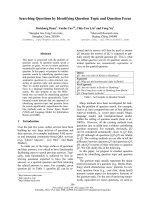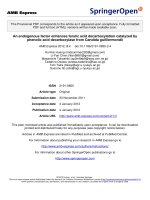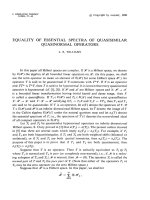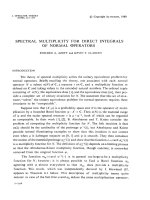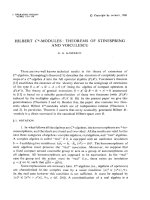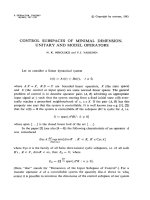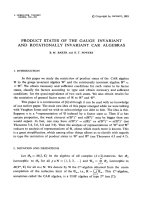Báo cáo toán học: "lattice tilings by cubes: whole, notched and extended" potx
Bạn đang xem bản rút gọn của tài liệu. Xem và tải ngay bản đầy đủ của tài liệu tại đây (132.14 KB, 11 trang )
lattice tilings by cubes: whole,
notched and extended
Mihail Kolountzakis
Department of Mathematics
1409 W. Green St.,
University of Illinois,
Urbana, IL 61801
Current Address:
Department of Mathematics
University of Crete
714 09 Iraklio, Greece
Submitted: April 14, 1997; Accepted: February 14, 1998.
Abstract
We discuss some problems of lattice tiling via Harmonic Analysis methods.
We consider lattice tilings of R
d
by the unit cube in relation to the Minkowski
Conjecture (now a theorem of Haj´os) and give a new equivalent form of Haj´os’s
theorem. We also consider “notched cubes” (a cube from which a reactangle
has been removed from one of the corners) and show that they admit lattice
tilings. This has also been been proved by S. Stein by a direct geometric
method. Finally, we exhibit a new class of simple shapes that admit lattice
tilings, the “extended cubes”, which are unions of two axis-aligned rectangles
that share a vertex and have intersection of odd codimension.
In our approach we consider the Fourier Transform of the indicator function
of the tile and try to exhibit a lattice of appropriate volume in its zero-set.
1991 Mathematics Subject Classification. Primary 52C22; Secondary 42.
the electronic journal of combinatorics 5 (1998), #R14 2
§0. Introduction
0.1 Results.
We obtain some results about translational tilings of R
d
with some simple classes
of of polyhedra as tiles (cubes as well as “notched” and “extended” cubes–see §2for
a definition of the latter shapes). The approach we use is to study the zero-set of
the Fourier Transform (FT) of the indicator function of the tile. If that set contains
a lattice except 0 then the set tiles R
d
when translated at the locations of the dual
lattice. This means that the translated copies of the tile cover (almost) every point
in R
d
a constant number of times–see Theorem 2.
In §1 we use our harmonic analysis approach to derive a new equivalent form of
the Minkowski conjecture (every lattice tiling of R
d
with the unit cube contains two
cubeswhichshareanentire(d−1)-dimensional face) which was proved by Haj´os [Haj]
in 1941. This new form of the Minkowski conjecture (Theorem 6) is an elementary
number-theoretic statement that involves no inequalities and could conceivably lead
to a new, elementary proof of the conjecture.
In §2 we prove that certain classes of polyhedra tile R
d
if translated by an appro-
priate lattice. The notched cube (see Figure 1) has already been shown by Stein [St]
to tile R
d
by a lattice (Conlan [Con] has done this in some cases). Stein’s method
was a direct geometric one. We give a new proof that the notched cube is a tile using
our approach. That is, we find lattices in the zero-set of the FT of the indicator
function of the notched cube, which is a very explicit function (see (11)). We find all
the tilings discovered by Stein, which, by a deeper theorem of Schmerl [Sch], is the
complete list of possible translational tilings (lattice or not) of the notched cube.
However, our approach for the notched cube leads us to the discovery of a whole
class of simple tiles of R
d
(the “extended cubes”–see Figure 2), for which we know of
no geometric proof of the fact that they tile. These tiles consist of two axis-aligned
rectangles which share a vertex and have intersection of odd codimension, and the
lengths of their sides can be completely arbitrary. The tiling lattices for each of these
tiles are very simple to describe. Furthermore, the proof that the notched cube tiles
essentially proves that the extended cubes tile as well, as the FT of the two indicator
functions (that of the notched cube and of that of the extended cube) have the same
form and differ only at the values of some parameters.
0.2 Translational tiling in R
d
.
Let f ∈ L
1
(R
d
)andA⊂R
d
be a discrete point set. We say that (the tile) f tiles
R
d
with (the tile set) A and with weight w if for almost all (Lebesgue) x ∈ R
d
we
have
a∈A
f(x − a)=w, (1)
where the series above converges absolutely. If f is the indicator function of a (mea-
surable) set T ⊂ R
d
then we also say that T (the tile) tiles R
d
with weight w,which
then has to be a nonnegative integer. When w = 1 we sometimes write
R
d
= T ⊕ A. (2)
the electronic journal of combinatorics 5 (1998), #R14 3
We restrict our attention to tile sets A of bounded density. That is, we demand that
#
A ∩ (x +[0,1]
d
)
≤ C, (3)
for all x ∈ R
d
and for some constant C, a requirement which is automatically fulfilled
whenever f ≥ 0.
0.3 A spectral condition for tiling.
In [KLa] a necessary and sufficient condition was given for (1) to hold. It was
proved for dimension d = 1 only. Here we state it for arbitrary d. We ommit the
proof as it is identical to the one-dimensional case.
For a tempered distribution µ we denote by µ its Fourier Transform (see for
example [Str]).
Theorem 1 Assume that f ∈ L
1
(R
d
) has Fourier Transform
f ∈ C
∞
(R
d
) and that
the discrete set A ⊂ R
d
is of bounded density. Write
µ =
a∈A
δ
a
, (4)
where δ
a
is a point mass at a.
(i) If f tiles R
d
with the tile set A and some weight w then
supp µ ⊆ Z := {0}∪
ξ∈R
d
:
f(ξ)=0
. (5)
(ii) If µ is locally a finite measure and supp µ ⊆ Z, then f tiles R
d
with the tile
set A and weight w = µ({0})
R
d
f.
Note that the requirement that
f ∈ C
∞
(R) is true for all f of compact support.
0.4 Fourier Transform and the Poisson Summation Formula.
The definition of Fourier Transform we use throughout this paper is
f(ξ)=
R
d
e
−2πiξ,x
f(x) dx,
for f ∈ L
1
(R
d
).
Let Λ = AZ
d
, A a non-singular n × n real matrix, be a lattice in R
d
and write
Λ
∗
=
x ∈ R
d
: ∀λ ∈ Λ x, λ∈Z
.
It turns out that Λ
∗
= A
−
Z
d
is a lattice which we call the dual lattice of Λ.
The Poisson Summation Formula (PSF)
λ∈Λ
ϕ(x − λ)=|det A|
−1
λ
∗
∈Λ
∗
ϕ(x − λ
∗
),
the electronic journal of combinatorics 5 (1998), #R14 4
valid for all smooth ϕ of compact support, can be written as a distribution identity
as follows:
λ∈Λ
δ
λ
∧
= |det A|
−1
λ
∗
∈Λ
∗
δ
λ
∗
. (6)
Our spectral criterion for tiling (Theorem 1) then takes the following simpler form
for lattice tilings.
Theorem 2 Assume that f ∈ L
1
(R
d
). Then f tiles R
d
with a lattice Λ and some
weight w if and only if
Λ
∗
\{0}⊆
ξ∈R
d
:
f(ξ)=0
. (7)
In this case we have w = |det Λ|
−1
R
d
f.
Proof. (without using Theorem 1) Let D be a fundamental parallelepiped of Λ. The
function
g(x)=
λ∈Λ
f(x−λ)
is defined as an absolutely convergent series for almost all x ∈ R
d
(since f ∈ L
1
(R
d
)),
is Λ-periodic, and g ∈ L
1
(D).
The dual group of D = R
d
/ΛisidentifiedwithΛ
∗
. That is the continuous
characters of R
d
/Λ are the functions
φ
λ
∗
(x)=exp(2πiλ
∗
,x),λ
∗
∈Λ
∗
,
and g is constant (i.e., f tiles with Λ) if and only if
f(λ
∗
)=g, φ
λ
∗
=0, ∀λ
∗
∈Λ
∗
\{0}.
An alternative would be to prove Theorem 2 for Λ = Z
d
using ordinary multiple
Fourier series and then use a linear transformation to get the general form of the
theorem.
Thus, a measurable T ⊆ R
d
tiles with Λ (in the ordinary sense of weight 1) if and
only if
1
T
vanishes on Λ
∗
\{0}and the volume of Λ is equal to that of T .
All tilings in §1and§2 are tilings of weight 1.
§1. The Minkowski Conjecture
1.1 Two equivalent forms of the conjecture.
Minkowski’s theorem on linear forms is the following statement.
Theorem 3 (Minkowski) If A ∈ M
d
(R) has det A =1then there is x ∈ Z
d
\{0}
such that
Ax
∞
≤ 1.
the electronic journal of combinatorics 5 (1998), #R14 5
Minkowski conjectured around 1900 that one can always get Ax
∞
< 1 except when
A has an integral row. This was proved by Haj´os [Haj] in 1941.
Theorem 4 (Haj´os) If A ∈ M
d
(R) has det A =1then there is x ∈ Z
d
such that
Ax
∞
< 1,
unless A has an integral row.
Haj´os actually worked on the following equivalent form of the Minkowski conjecture,
which involves lattice tilings by a cube. This form was already known to Minkowski
and most results on Minkowski’s conjecture leading up to Haj´os’s eventual proof have
used this form.
Theorem 5 If Q =[−1/2,1/2]
d
is a cube of unit volume in R
d
, Λ ⊂ R
d
is a lattice,
and
R
d
= Q ⊕ Λ
is a lattice tiling of R
d
then there are two cubes in the tiling that share a (d − 1)-
dimensional face. In other words, for some i =1, ,d, the standard basis vector
e
i
=(0, ,0,1,0, ,0)
∈ Λ.
Before going on to describe a new equivalent form of the Minkowski conjecture (The-
orem 6) we sketch a proof of the equivalence of Theorems 4 and 5.
Theorem 4 =⇒ Theorem 5.
Let Λ = AZ
d
with det A =1,Q⊕Λ=R
d
. Then, either there is a non-zero Λ-point
in the interior of 2Q or A has an integral row. The first cannot happen because of
the tiling assumption. Therefore a
ij
∈ Z for some i and for all j. Again because of
tiling it follows that gcd(a
i1
, ,a
i,d
) = 1. Let R
d−1
be the subspace spanned by all
e
j
, j = i, and define Λ
=Λ∩R
d−1
and Q
= Q∩R
d−1
. It follows that R
d−1
=Λ
⊕Q
is a tiling of R
d−1
. By induction then Λ
contains some vector of the standard basis
and so does Λ.
Theorem 5 =⇒ Theorem 4.
Theorem 5 easily implies the seemingly stronger statement that, if AZ
d
⊕ Q = R
d
is a tiling then, after a permutation of the coordinate axes, the matrix A takes the
form
100 0
a
2,1
10 0
a
d,1
1
(8)
Using this remark, if AZ
d
∩(−1, 1)
d
= {0} we get, since det A =1,thatAZ
d
⊕Q=R
d
and, therefore, A is (after permutation of the coordinate axes) of the type (8), and
thus has an integral row (which property is preserved under permutation similarity).
1.2 A new equivalent form.
In this section we prove that the following is equivalent to the Minkowski conjec-
ture (Theorems 4 and 5).
the electronic journal of combinatorics 5 (1998), #R14 6
Theorem 6 Let B ∈ M
d
(R) have det B =1and the property that for all x ∈ Z
d
\{0}
some coordinate of the vector Bx is a non-zero integer. Then B has an integral row.
Remark. One might think that Theorem 6 can be proved equivalent directly to The-
orem 4, which it resembles most. It is, indeed, clear that Theorem 4 implies Theorem
6. However, the proof that is given here is that of the equivalence of Theorems 6 and
5 using our spectral criterion for tilings (Theorem 2) and I do not know of a more
direct proof that Theorem 6 implies Theorem 4.
We shall need the following simple lemma.
Lemma 1 Let A ∈ M
d
(R) be a non-singular matrix. The lattice A
−
Z
d
contains
the basis vector e
i
if and only if the i-th row of A is integral.
Proof. Without loss of generality assume i =1.
If e
1
∈ A
−
Z
d
then e
1
= A
−
x for some x ∈ Z
d
. Therefore, for all y ∈ Z
d
we have
(Ay)
1
= e
1
Ay = x
A
−1
Ay = x
y ∈ Z.
It follows that (Ay)
1
∈ Z for all y ∈ Z
d
and the first row of A is integral.
Conversely, if the first row of A is integral, then, for all y ∈ Z
d
Z (Ay)
1
= x
y,
where A
−
x = e
1
(x ∈ R
d
). It follows that x ∈ Z
d
and e
1
∈ A
−
Z
d
.
Proof of the equivalence of Theorems 5 and 6.
Let f (x)=1(x∈Q) be the indicator function of the unit-volume cube Q =
[−1/2, 1/2]
d
. A simple calculation shows that
f(ξ)=
d
j=1
sin πξ
j
πξ
j
, (9)
so that
Z =
f =0
=
ξ∈R
d
: some ξ
j
is a non-zero integer
. (10)
Therefore, if Λ = B
−
Z
d
then (since Λ has volume 1)
Q ⊕ Λ=R
d
⇐⇒ Λ
∗
\{0}⊆Z,
where Λ
∗
= BZ
d
, by Theorem 2. In words, Q tiles with Λ if and only if for every
x ∈ Z
d
\{0}the vector Bx has some non-zero integral coordinate.
Theorem 5 =⇒ Theorem 6.
Suppose x ∈ Z
d
\{0} implies some (Bx)
i
∈ Z \{0}.ThenQ⊕Λ=R
d
and from
Theorem 5, say, e
1
∈ Λ, which, from Lemma 1, implies that the first row of B is
integral.
Theorem 6 =⇒ Theorem 5.
Assume Q ⊕ Λ=R
d
. It follows that for every x ∈ Z
d
\{0}the vector Bx has some
non-zero integral coordinate. By Theorem 6 B must have an integral row, which, by
Lemma 1, implies that some e
i
∈ Λ.
the electronic journal of combinatorics 5 (1998), #R14 7
Figure 1: A notched cube in R
3
.
§2. The notched and the extended cube
In this section we prove that some simple shapes (like those in Figures 1 and 2) admit
lattice tilings. That the “extended cubes” (Fig. 2–see Theorem 8) admit lattice tilings
has not been shown before.
2.1 The notched cube
We now consider the unit cube
Q =
−
1
2
,
1
2
d
from whose corner (say in the positive orthant) a rectangle R has been removed with
sides-lengths δ
1
, ,δ
d
(0 ≤ δ
j
≤ 1). That is, we consider the “notched cube”:
N = Q \ R
where
R =
d
j=1
1
2
− δ
j
,
1
2
.
It is shown in Figure 1.
We give a new proof of the following result of Stein [St].
Theorem 7 The notched cube N admits a lattice tiling of R
d
.
After a simple calculation we obtain
1
N
(ξ)=
d
j=1
sin πξ
j
πξ
j
− F(ξ)
d
j=1
sin πδ
j
ξ
j
πξ
j
, (11)
the electronic journal of combinatorics 5 (1998), #R14 8
where F(ξ)=exp(πiK(ξ)) with
K(ξ)=
d
j=1
(δ
j
− 1)ξ
j
. (12)
Using Theorem 2 it is enough to exhibit a lattice Λ ⊂ R
d
, of volume equal to
|N| =1−δ
1
···δ
d
,
such that
1
N
vanishes on Λ
∗
\{0}.
2.2 Lattices in the zero-set
We define the lattice Λ
∗
as those points ξ for which
ξ
1
− δ
2
ξ
2
= n
1
,
ξ
2
− δ
3
ξ
3
= n
2
,
(13)
ξ
d
− δ
1
ξ
1
= n
d
,
for some n
1
, ,n
d
∈Z.Thatis,Λ
∗
=A
−1
Z
d
,where
A=
1 −δ
2
1 −δ
3
.
.
.
1 −δ
d
−δ
1
1
. (14)
Therefore Λ = A
Z
d
and the volume of Λ is equal to |det A|. Expanding A along the
first column we get easily that det A =1−δ
1
···δ
d
, which is the required volume.
We now verify that
1
N
vanishes on Λ
∗
\{0}.
Assume that 0 = ξ ∈ Λ
∗
. Adding up the equations in (13) we get
K = K(ξ)=−(n
1
+···+n
d
).
If all the coordinates of ξ are non-zero we can write
1
N
(ξ)=
1
π
d
ξ
1
···ξ
d
d
j=1
sin πξ
j
− (−1)
K
d
j=1
sin πδ
j
ξ
j
. (15)
Observe from (13) that
sin πξ
j
=(−1)
n
j
sin πδ
j+1
ξ
j+1
,
where the subscript arithmetic is done modulo d, from which we get
1
N
(ξ) = 0, since
the factors in the two terms of (15) match one by one.
the electronic journal of combinatorics 5 (1998), #R14 9
It remains to show that
1
N
(ξ)=0evenwhenξhas some coordinate equal to 0,
say ξ
1
=0.
Consider the numbers ξ
1
, ,ξ
d
arranged in a cycle and let
I = {ξ
m
,ξ
m+1
, ,ξ
1
, ,ξ
k−1
,ξ
k
}
be an interval around ξ
1
which is maximal with the property that all its elements are
0. Then ξ
m−1
= 0 and ξ
k+1
= 0 and from (13) we get
ξ
m−1
− δ
m
ξ
m
= n
m
and ξ
k
− δ
k+1
ξ
k+1
= n
k
. (16)
We deduce that n
m
and n
k
are both non-zero and therefore that ξ
m−1
and δ
k+1
ξ
k+1
are both non-zero integers and sin πξ
m−1
=sinπδ
k+1
ξ
k+1
= 0. This means that both
terms in (11) vanish and so does
1
N
(ξ).
So we proved that for the lattice Λ = A
Z
d
,whereAis defined in (14), we have
N ⊕ Λ=R
d
. Clearly, if σ is a cyclic permutation of {1, ,d} and if instead of the
matrix A we have the matrix A
whose i-th row has 1 on the diagonal, −δ
σi
at column
σi and 0 elsewhere, we get again a lattice tiling with the lattice (A
)
Z
d
.Stein[St]
as well as Schmerl [Sch] have shown that these (d − 1)! lattice tilings of the notched
cube (one for each cyclic permutation of {1., ,d}) are all non-isometric when the
side-lengths δ
j
are all distinct.
A deeper result of Schmerl [Sch] is that there are no other translational tilings
of the notched cube, lattice or not. This is something that I cannot prove with the
harmonic analysis approach.
2.3 Extended cubes
Let us now allow the parameters δ
1
, ,δ
d
to take on any non-zero real value
subject only to the restriction
δ
1
···δ
d
=1, (17)
and let the function ϕ(ξ) be equal to the right-hand side of (11). Let again the matrix
A be defined by (14) and Λ = A
Z
d
as before. We have again det A =1−δ
1
···δ
d
.
The calculations we did in §2.2 show that ϕ vanishes on Λ
∗
\{0}, hence, if ˇϕ is
the inverse FT of ϕ,ˇϕtiles R
d
with Λ and weight
ϕ(0)
|1 − δ
1
···δ
d
|
=sgn(1−δ
1
···δ
d
), (18)
where sgn(x)=±1 is the sign of x.
The function ˇϕ is given by
ˇϕ(x)=1
Q
(x)−sgn(δ
1
···δ
d
)ψ(x), (19)
where
ψ(x)=1
Q
x
1
−(1 − δ
1
)/2
|δ
1
|
, ,
x
d
−(1 − δ
d
)/2
|δ
d
|
. (20)
the electronic journal of combinatorics 5 (1998), #R14 10
Figure 2: Some extended cubes in R
3
that admit lattice tilings. The codimension of the intersection
is 1 (left) and 3 (right).
Notice that ψ(x) is the indicator function of a rectangle R = R(δ
1
, ,δ
d
) with side-
lengths |δ
1
|, ,|δ
d
| centered at the point
P =
1
2
, ,
1
2
−
1
2
(δ
1
, ,δ
d
). (21)
The rectangle R intersects the interior of Q only in the case δ
1
> 0, ,δ
d
> 0and
when this happens ˇϕ is an indicator function only if we also have δ
1
≤ 1, ,δ
d
≤1,
which is the case of the notched cube that we examined in §2.2.
Otherwise (not all the δs are non-negative) ˇϕ is an indicator function only when
sgn(δ
1
···δ
d
)=−1, i.e., the number of negative δs is odd. In this case we have that
ˇϕ = 1
Q∪R
and from (18) we get that Q ∪ R tiles with Λ and weight 1. We can now prove the
following.
Theorem 8 (Lattice tiling by extended cubes)
Let Q and R be two axis-aligned rectangles in R
d
with sides of arbitrary length and
disjoint interiors. Assume also that Q and R have a vertex K in common and inter-
section of odd codimension.
Then Q ∪ R admits a lattice tiling of R
d
of weight 1.
For example, the extended cubes shown in Figure 2 admit lattice tilings of R
3
.
Proof. After a linear transformation we can assume that Q =[−1/2,1/2]
d
,thatQ
and R share the vertex K =(1/2, ,1/2) and that Q ∩ R has codimension k (an
the electronic journal of combinatorics 5 (1998), #R14 11
odd number) and
Q ∩ R ⊆
x ∈ Q : x
1
= ···=x
k
=
1
2
.
Let the side-lengths of R be γ
1
, ,γ
d
>0. Define
δ
j
=
−γ
j
, if 1 ≤ j ≤ k,
γ
j
, if k +1≤j≤d.
It follows that, with this assignment for the δ
j
, the indicator function of R is equal to
the function −sgn(δ
1
···δ
d
)ψ(x) of (19) and tiling follows from the previous discussion.
I believe that extended cubes with an intersection of even codimension do not tile,
at least not for general side-lengths. This is clear in dimension two and it is conceivable
that some combinatorial argument could easily show this in any dimension. The
Harmonic Analysis approach does not seem to be very helpful when one tries to
disprove that something is a (translational) tile.
§3. Bibliography
[Con] J.P Conlan, Derived tilings, J. Comb. Th. (A) 20 (1976), 34-40.
[Haj] G. Haj´os,
¨
Uber einfache und mehrfache Bedeckung des n-dimensionalen
Raumes mit einem W¨urfelgitter, Math. Z. 47 (1941), 427-467.
[K] M.N. Kolountzakis, A new estimate for a problem of Steinhaus, Inter. Math.
Res. Notices, 1996, 11, 547-555.
[KLa] M.N. Kolountzakis and J.C. Lagarias, Tilings of the line by translates of a
function, Duke Math. J. 82 (1996), 3, 653-678.
[Sch] J.H. Schmerl, Tiling space with notched cubes, Discr. Math. 133 (1994),
225-235.
[St] S. Stein, The notched cube tiles R
n
,Discr.Math.80 (1990), 335-337.
[Str] R. Strichartz, A guide to distribution theory and Fourier Transforms,CRC
Press, Boca-Raton, Florida (1994).

